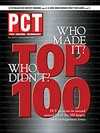The tree squirrel is the most common urban wild animal seen around urban and suburban areas throughout the country. In fact, about the time you are reading this, many tree squirrels of the country will have just successfully produced and reared their spring litters; the young squirrels are now out of the nest and foraging about on their own. Some urbanites perceive squirrels as a cute and an interesting part of their local urban ecosystem while others pay little or no attention to them. But property owners should view tree squirrels with concern and caution. And wildlife and pest professionals should be proactive in informing the public of the pest significance of urban tree squirrels. This is because at the least, tree squirrels can be annoying. At the worst, they can cause disease, cause expensive power outages and even cause the loss of human life.
Four groups of tree squirrels are most common in the U.S. These include gray, fox, pine and flying squirrels. At least eight different species and many sub-species exist among these groups. The gray and fox squirrels are the most common and abundant species and overlap broadly in the Eastern half of the U.S. The distribution of the tree squirrel species in an area can be determined via state wildlife agencies or by reviewing the species distribution maps on tree squirrels at the University of Nebraska’s wildlife damage Web site at www.wildlifedamage.unl.edu/ or at other wildlife damage Web sites.
EXCEPTIONAL GNAWERS. Tree squirrels are members of the mammal order Rodentia. The word "rodent" originates from the Latin word "rodere" meaning "to gnaw." Gnawing serves as an important "tool" for squirrels. By gnawing, squirrels can open and access tree nuts, seeds and berries, as well as gain access into tree and other cavities to build nests.
The gnawing potential of the tree squirrels around buildings cannot be taken lightly. Consider the relative size of these rodents. The gray and fox squirrels can weigh up to 1.75 lb/794 g and 3.0 lbs/1360 g respectively. Associated with these large body sizes are large, powerful and continuously growing incisor teeth that measure up to 15 mm or more for the lower incisors and 10 mm or more for the upper incisors with which they can exert biting pressures exceeding 7,000 psi. Appreciating the gnawing behavior of these mammals sets the stage for us to understand their potential destructiveness in and around urban dwellings and utility systems.
STRUCTURAL DAMAGE. Tree squirrels damage structural support timbers, wooden siding, cedar shingles and virtually any stored item. Those wildlife and pest management professionals who have witnessed tree squirrels trapped inside cabins and residences can attest to the destruction to furniture, carpeting and window and door encasements. Although such damage is upsetting to the property owners, it is also an impressive display as to the physical strength and capabilities of these mammals to cause destruction and havoc to human structures and components.
POWER SHUTDOWNS. Tree squirrels readily gnaw on the electrical wires installed in attics, walls and ceilings, causing shortages and/or significant structural fires. Ever since electricity has been developed and channeled via urban utility infrastructures, tree squirrels have been responsible for millions of dollars in power shutdown damage all around the world. Thousands of community-wide power outages occur all around the country every year due to squirrel gnawing damage or activity at neighborhood transformer stations and overhead electrical lines.
Squirrels also readily attack many different types of cable and telephone wires both inside and outside. I have had my telephone and computer Internet services shut down for a day or more eight times throughout the past five years due to tree squirrel damage to telephone lines several blocks from my home.
DISEASE POTENTIAL. Overall, tree squirrels are not considered a major disease threat to humans, although they can’t be dismissed in this regard either. Encephalitus viruses have been reported from fox and gray squirrels in Ohio, Wisconsin, California and Colorado. An outbreak of plague occurred among urban fox squirrels in Denver, Colo., in 1968. Some tree squirrels have been found infected with the pathogenic bacteria associated with leptospirosis, clostridium and tuleremia.
Moreover, a fascinating research paper published in Parasitology Today in 1987 by J. McDade titled: Flying squirrels and their ectoparasites. Disseminators of epidemic typhus revealed the importance of the southern flying squirrel (Glaucomys volans), a common attic-infesting species in the Eastern half of the United States in the transmission of sylvatic epidemic typhus (a relative of murine typhus) to humans. The victims occupying the squirrel-infested buildings were never bitten by the squirrel’s ectoparasites (recall that with murine typhus, contact with infected flea feces and possibly flea bites are required for transmission of the rickettsial organism). The exact mode of the transmission of the typhus organism remains uncertain. One hypothesis is that the rickettsiae were inhaled from aerosolized forms of the feces from one or possibly two of the flying squirrel’s ectoparasites: the squirrel sucking louse (Neohaematopinus sciuriopteri) and possibly the squirrel flea Orchopeas howardii, present in the attic.
This research has important personal protection procedure ramifications for wildlife and pest management professionals relative to working in squirrel-infested attics and other spaces. (For more information, see my Vertebrate Pests column in the October 1997 issue of PCT.)
ECTOPARASITES. Squirrel nests inside attics and walls can harbor populations of fleas, ticks, lice and other ectoparasites. In fact, research has shown that tree squirrels serve as hosts to a wide range of ectoparasites. Some of the ectoparasites are host-specific (i.e., they feed almost exclusively on the squirrels), while others may attack a wide range of hosts, including humans. Some of the squirrel’s ectoparasites are proven vectors of diseases such as Rocky Mountain spotted fever, human monocytic ehrlichiosis, typhus and others.
In one comprehensive Indiana study of the ectoparasites of 284 tree squirrels, the host-specific squirrel flea (O. howardii) was the most common flea found, while only one cat flea (Ctenocephalides felis) was found among all squirrels. Several species of ticks including the common American dog tick (Dermancentor vari-abilis) and the lone star tick (Amblyomma americanum), both of which feed on people, were found in small numbers parasitizing the gray and fox squirrels. The flying squirrel sucking louse, (N. sciuriopteri), the louse shown capable of maintaining and transmitting the typhus rickettsia to uninfected squirrels, was found on five of 10 southern flying squirrels.
STORED PRODUCT PESTS. Because squirrels commonly collect and store large amounts of seeds, nuts and berries, their caches inside walls, ceilings and attics present a strong possibility of causing stored product pest infestations (e.g., Indian meal moth, dermestid beetles). Often these inaccessible caches are the reasons behind the more persistent and "unsolvable" grain and beetle moth infestations inside residences. Such insect infestations are especially likely when tree squirrels are feeding and collecting food from residential bird feeders.
LANDSCAPE DAMAGE. Tree squirrels often gnaw on and damage a wide variety of trees and shrubs in urban environments. Bark stripping of various hardwoods is common. Even well established, older trees are sometimes killed when tree squirrels attack and remove the tree’s entire trunk bark. Squirrels also will nip off hundreds of limbs and twigs of evergreens and other trees and shrubs.
ANNOYANCE. Finally, tree squirrels can be a significant annoyance to property owners. Squirrels running about in attics or climbing about within walls are noisy and frightening to building occupants. The characteristic loud "thump" of a flying squirrel landing on the attic floor (i.e., a bedroom’s ceiling) and then scurrying about late at night can be truly frightening to anyone, regardless of age.
Considering everything discussed above, perhaps a frightened child coming into a parent’s bedroom late at night complaining of "monsters" in their room isn’t so far removed from the truth.
The author is president of RMC Pest Management Consulting and can be reached at 765/939-2829 or rcorrigan@pctonline.com.

Explore the May 2003 Issue
Check out more from this issue and find your next story to read.
Latest from Pest Control Technology
- Neighborly Pest Management Continues Fighting Invasive Pest
- Rollins Reports Q1 Revenues Up 9.9% YOY
- Are You Covering Your Marketing Basics?
- Did You Order Mice With That?
- Arrow Exterminators Opens New Residential Service Center in Metro Atlanta
- CAPMA Hosts 2025 Legislative Day in Sacramento
- Grizz Pest Management Bartends for a Cause
- Rose Pest Solutions Becomes Official Pest Provider of Chicago Fire FC





